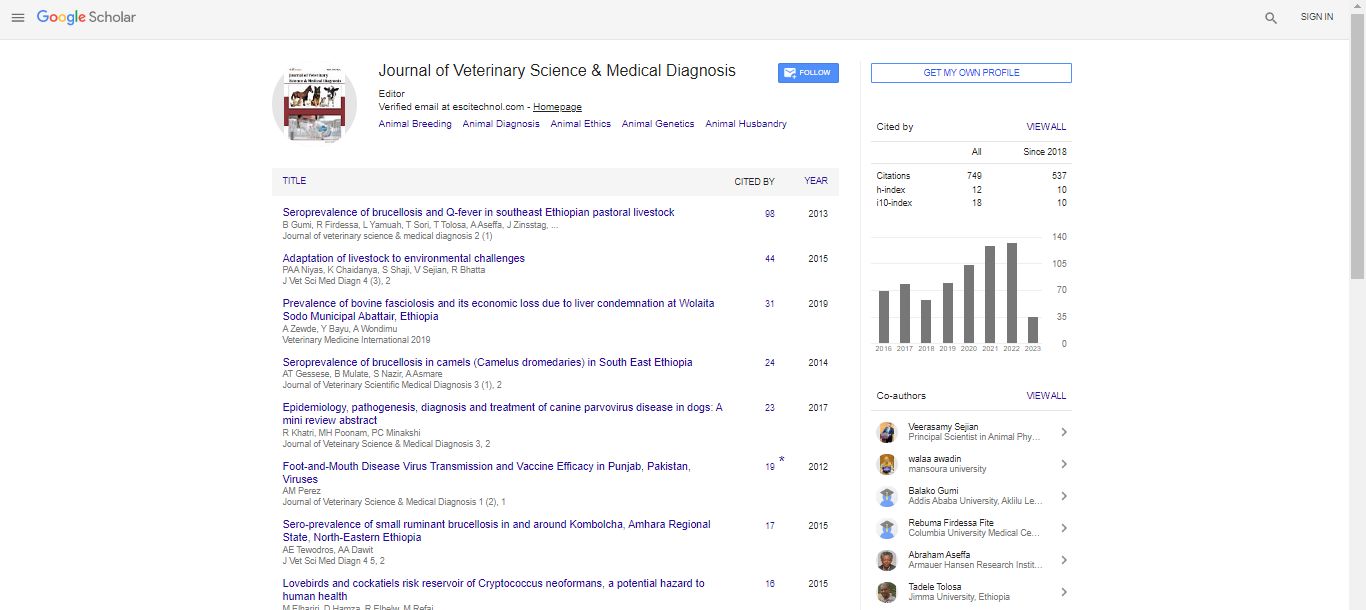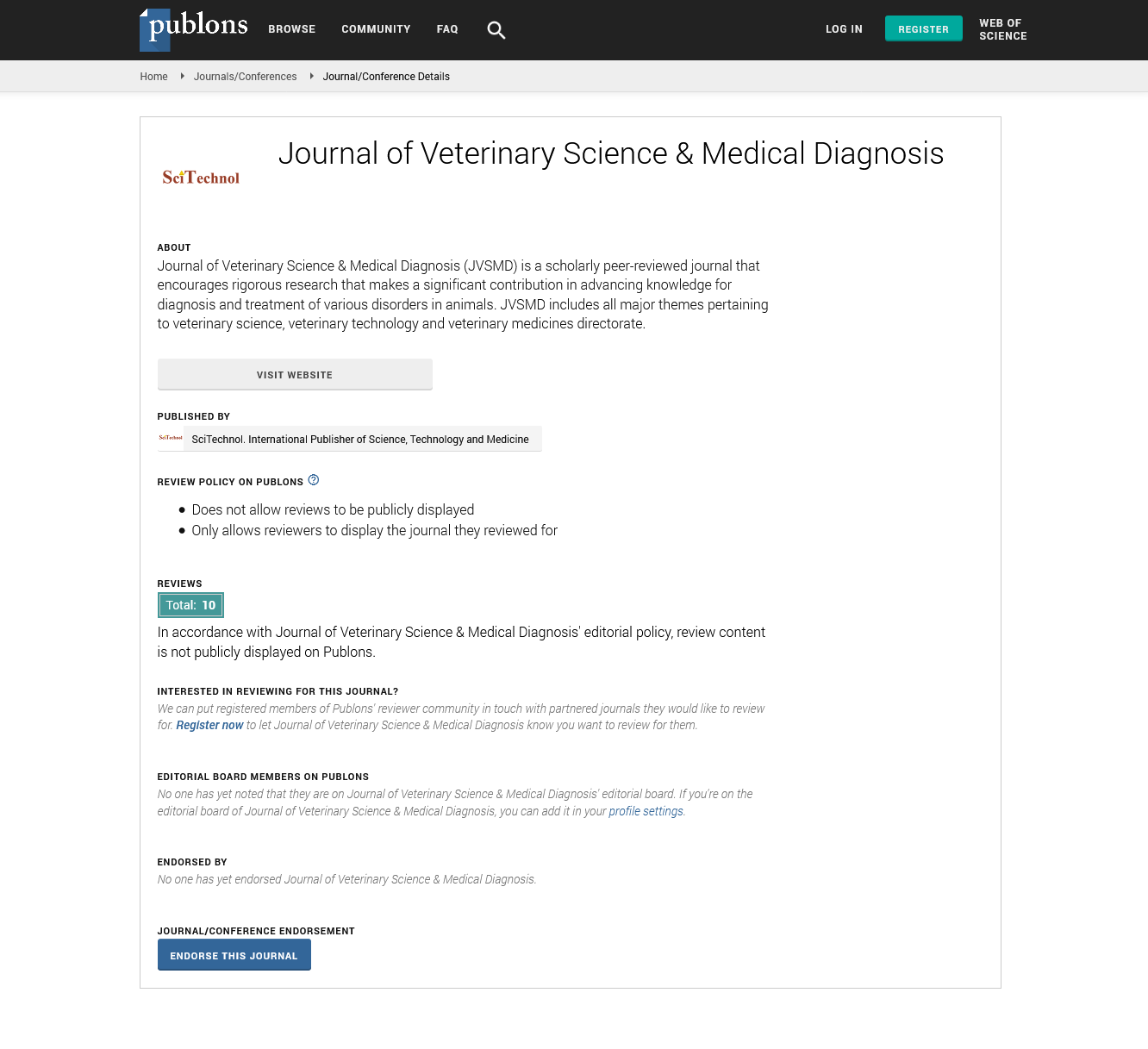Commentary, J Vet Sci Med Diagn Vol: 13 Issue: 2
Antiviral Therapies in Veterinary Medicine: Challenges in Treating Animal Viral Infections
Mohammad Hesham*
Department of Virology, Zagazig University, Zagazi, Egypt
- *Corresponding Author:
- Mohammad Hesham
Department of Virology,
Zagazig University,
Zagazi,
Egypt;
E-mail: mohamhes@vet.suez.edu.eg
Received date: 13 March, 2024, Manuscript No. JVSMD-24-154226;
Editor assigned date: 15 March, 2024, PreQC No. JVSMD-24-154226 (PQ);
Reviewed date: 29 March, 2024, QC No. JVSMD-24-154226;
Revised date: 09 April, 2024, Manuscript No. JVSMD-24-154226 (R);
Published date: 16 April, 2024, DOI: 10.4172/2325-9590.1000088
Citation: Hesham M (2024) Antiviral Therapies in Veterinary Medicine: Challenges in Treating Animal Viral Infections. J Vet Sci Med Diagn 13:2.
Description
Antiviral therapies have revolutionized human medicine, offering treatments for a range of viral infections, but their application in veterinary medicine presents unique challenges. While significant progress has been made in the development of antiviral drugs for animals, treating viral infections in livestock, companion animals and wildlife remains complex. The challenges stem from issues such as the diversity of viruses, economic and regulatory concerns, limited research funding and the need for species-specific treatments. This essay explores these challenges in detail and highlights the importance of finding effective antiviral therapies for veterinary use.
One of the most significant challenges in developing antiviral therapies for veterinary medicine is the sheer diversity of viruses that affect animals. Animal viruses vary widely across species, making it difficult to develop one-size-fits-all solutions. Viruses that affect livestock, such as Foot-and-Mouth Disease (FMD), avian influenza and African swine fever, are often highly contagious and can cause devastating economic losses. Meanwhile, companion animals like dogs and cats are affected by viruses such as canine parvovirus, feline leukaemia virus and respiratory infections caused by viruses like distemper and herpes virus.
Each of these viruses has distinct mechanisms of infection, replication and pathogenesis, which requires tailored therapeutic approaches. For example, while antiviral drugs for herpes viruses might focus on inhibiting viral DNA replication, treatments for retroviruses, such as Feline Immunodeficiency Virus (FIV), may target reverse transcriptase enzymes. This complexity means that research and development of antiviral treatments must be highly specialized, increasing the time and cost required for discovery and approval.
Another barrier to antiviral drug development in veterinary medicine is the stringent regulatory framework for veterinary drugs. Unlike human medicines, veterinary drugs often face additional challenges in gaining regulatory approval, as agencies like the U.S. Food and Drug Administration (FDA) or European Medicines Agency (EMA) require extensive safety and efficacy trials. These trials are costly, time-consuming and resource-intensive, particularly when testing antiviral drugs across a wide range of animal species.
Furthermore, the economic incentives for developing antiviral treatments for animals are often limited. For many viral diseases, particularly those affecting livestock, farmers may prefer nonpharmaceutical interventions, such as vaccination, which are more cost-effective in preventing widespread outbreaks. Research into antiviral therapies for animals is also limited compared to human virology, with fewer resources allocated to studying animal-specific viruses. This scarcity of research hinders the development of effective treatments for veterinary use. The high cost of antiviral therapies, coupled with concerns about their economic viability in farming systems, means that drug development is often not prioritized.
As with human medicine, the potential for antiviral resistance is a growing concern in veterinary medicine. Overuse or inappropriate use of antiviral drugs could lead to the development of resistant strains of viruses, making future treatment options less effective. This is particularly concerning in the context of farming, where animals are often treated with medications in large-scale, intensive systems.
In conclusion, the development of antiviral therapies in veterinary medicine faces numerous challenges, including the complexity and diversity of animal viruses, regulatory hurdles, limited research funding and concerns about resistance and ethical implications. Despite these challenges, advancements are being made, particularly in the development of vaccines and targeted antiviral drugs. To overcome these obstacles, increased investment in veterinary virology research, collaboration between veterinarians, scientists and pharmaceutical companies and the exploration of new therapeutic approaches are needed. With continued innovation, antiviral therapies will play an essential role in improving animal health and safeguarding agricultural and public health.
 Spanish
Spanish  Chinese
Chinese  Russian
Russian  German
German  French
French  Japanese
Japanese  Portuguese
Portuguese  Hindi
Hindi 
